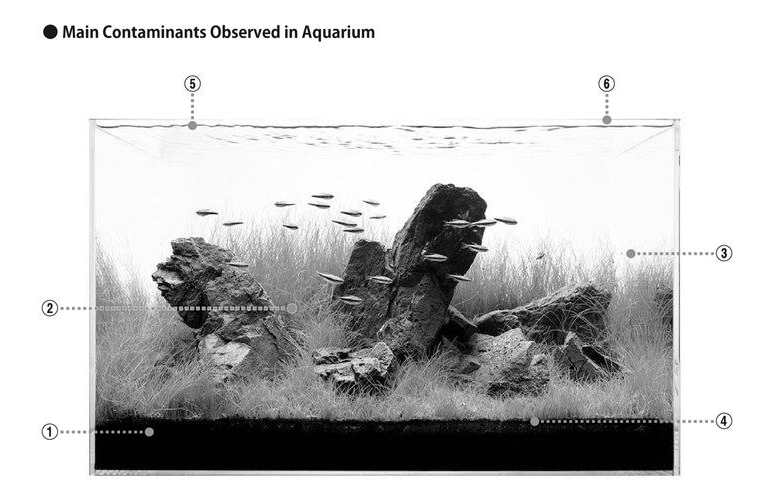Even a Nature Aquarium with lush beautiful aquatic plants would gradually get dirty with algae or other contaminants if it is left without regular cleaning and maintenance including glass cleaning and change of aquarium water. As we all know, some aquaria get dirty in a short period of time while some do not. What are the differences between them? This section looks into this issue by investigating the causes of aquarium contamination.
Feces of fishes and shrimps as well as leftover fish food falls onto the substrate and will be eventually broken down by bacteria. The brown-colored substance generated in this process is sludge. It is not very noticeable if the entire substrate is covered by thick plants, but it is obvious particularly in the aquarium with cosmetic sand substrate. Not only being unsightly, sludge can become a source of nitrogen and phosphorus which causes algae problem if excessively accumulated. Furthermore, the sludge dispersed in water goes inside the gill of fish and may cause gill disease. It is advised to remove sludge as much as possible during water change to keep the aquarium clean
Algae such as brown ribbon-like diatom and filamentous green algae are one of the most noticeable and problematic contaminants of aquarium. In particular, algae grown on the glass surface is observed in every tank. Algal spores exist in air and there is no way to prevent them from entering the aquarium. Therefore, it is impossible to control the algal growth. Algae usually grow faster when the aquarium water contains more nutrients including nitrogen and phosphorus. These nutrients should be reduced by way of water change. It is also effective to remove sludge which is a source of these nutrients and also reduce the amount of fish feed if it is too much.
The aquarium looks unclean if there are too many snails in it. Snails enter the aquarium when aquatic plants with eggs attached to them, or with adult snails on them are brought into the aquarium Most of snails are hermaphrodite and multiply rapidly. If they are left untreated, many of them will eventually stick on the aquarium glass and become an eyesore. Since it is hard to completely remove snails , it is important to reduce their numbers frequently by removing as many of them as possible during water change and scooping them out of the the aquarium glass at night. It is advised to remove eggs of snails immediately when they are found on aquatic plants or glass surface of the tank.
Cloudy water is one of the aspects which spoil the appearance of planted aquarium. The possible causes of cloudy water include fine particles from the substrate, bacteria suspended in water, algal bloom and yellowing attributed to driftwood. The problem of cloudy water can be temporarily improved by water change, but it will recur unless the root cause is resolved. If cloudy water is caused by fine particles from the substrate, it is necessary to reduce the excessive number of Shrimps or improve the situation where driftwood is exposed directly to water flow. The use of an UV Lamp is effective to get rid of the bacteria and algae in water while the use of activated carbon helps improve the yellow water and control of organic compounds in water
Even if the water is clear, the aquarium looks unclean if a film is formed on the water surface. The main cause of this film is due to organic matters generated from dead bacteria and floating on the water surface. With a film present on the water surface, the bubbles get stuck under the film and sometimes harden with bacteria grown in them.
Unlike fragments of aquatic plants floating on the water surface, it is impossible to scoop and remove the film formed on water. Besides the use of an effective Surface Skimmer, you may easily improve and prevent the film on the water surface by using the water flow from the Filter (outflow). The effects of aeration and film removal are obtained by moving the Filter Outlet Pipe (outflow), while the light is off during night, to a higher position at which air is taken into the water flow from the outflow port.
White water stains can be observed on aquarium glass after water drops dry up. Various substances including calcium and magnesium are dissolved in aquarium water and when water is evaporated, only these substances are left as dirt: this is water stain. If the water stain has not yet become stubborn, it can be removed by wetting the glass and wiping it off with a cloth. However, if it is left uncleaned, it will not just come off by this method.
The portion between the water surface and the top end of the tank is particularly prone to water stains and becomes whitish easily since wet and dry states repeatedly occur on this area. Water stains, which dissolve in acid, can effectively be removed by using vinegar or be Soft.
